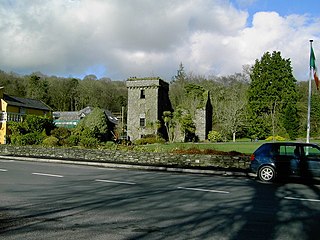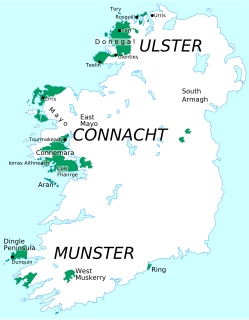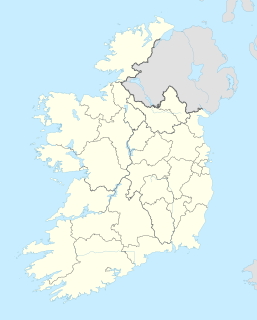Related Research Articles
The vast majority of placenamesin Ireland are anglicisations of Irish language names; that is, adaptations of the Irish names to English phonology and spelling. However, some names come directly from the English language, and a handful come from Old Norse and Scots. The study of placenames in Ireland unveils features of the country's history and geography and the development of the Irish language. The name of Ireland itself comes from the Irish name Éire, added to the Germanic word land. In mythology, Éire was an Irish goddess of the land and of sovereignty.

Máirtín Ó Cadhain was one of the most prominent Irish language writers of the twentieth century. Perhaps best known for his 1949 work Cré na Cille, Ó Cadhain played a key role in bringing literary modernism to contemporary Irish language literature. Politically, he was an Irish nationalist and socialist, promoting the Athghabháil na hÉireann, through Gaelic culture. He was a member of the post-Civil War Irish Republican Army with Brendan Behan during the Emergency.

Inverin is a Gaeltacht village between Baile na hAbhann and Minna in County Galway, Ireland. There are Irish-language summer colleges in the area, most notably Coláiste Lurgan and Coláiste Uí Chadhain.

Ballyvourney is a Gaeltacht village in southwest County Cork, Ireland. It is a civil parish in the barony of Muskerry West, and is also an ecclesiastical parish in the Roman Catholic Diocese of Cloyne. Ballyvourney is part of the Cork North-West Dáil Constituency.

Ulster Irish is the variety of Irish spoken in the province of Ulster. It "occupies a central position in the Gaelic world made up of Ireland, Scotland and the Isle of Man". Ulster Irish thus has more in common with Scottish Gaelic and Manx. Within Ulster there have historically been two main sub-dialects: West Ulster and East Ulster. The Western dialect is spoken in County Donegal and once was in parts of neighbouring counties, hence the name Donegal Irish. The Eastern dialect was spoken in most of the rest of Ulster and northern parts of counties Louth and Meath.

Connacht Irish is the dialect of the Irish language spoken in the province of Connacht. Gaeltacht regions in Connacht are found in Counties Mayo and Galway. Connacht Irish is also spoken in the Meath Gealtacht Ráth Chairn and Bailie Ghib. The dialects of Irish in Connacht are extremely diverse, with the pronunciation, forms and lexicon being different even within each county. The Irish of South Connemara is often considered the "standard" Connacht Irish owing to the number of speakers however it is unique within Connacht and has a lot more idiomatic connection to extinct dialects in North Clare. Words such as "dubh" and snámh tend to be pronounced with a Munster accent in South Connemara whereas in Joyce Country, Galway City and Mayo they are pronounced with the Ulster pronunciation. In addition to this the standard in Connacht would be to pronounce the words "leo" and "dóibh" as "leofa" and "dófa" however in South Connemara and Aran they are pronounced "Leothab" and "dóib". Lexical and pronunciation differences exist within Mayo with Tourmakeady featuring an "í" sound in vowel endings much more commonly. In addition to this the lexicon of Dún Chaocháin to the east of Belmullet tends to be far more Ulster influenced than that of Eachléim and there is a huge Ulster influence on the dialect of North Mayo in general owing to historic migration. The Irish of Eachréidh na Gaillimhe and Dúiche Sheoigheach tend to share more phonetic commonalities with neighbouring Mayo than with South Connemara

Munster Irish is the dialect of the Irish language spoken in the province of Munster. Gaeltacht regions in Munster are found in the Gaeltachtaí of the Dingle Peninsula in west County Kerry, in the Iveragh Peninsula in south Kerry, in Cape Clear Island off the coast of west County Cork, in Muskerry West; Cúil Aodha, Ballingeary, Ballyvourney, Kilnamartyra, and Renaree of central County Cork; and in an Rinn and an Sean Phobal in Gaeltacht na nDéise in west County Waterford.

Kilsheelan is a village and civil parish within the in the barony of Iffa and Offa East in County Tipperary, Ireland. It is also one half of the Roman Catholic parish of Kilsheelan & Kilcash in the Roman Catholic Diocese of Waterford and Lismore.
Muskerry is a central region of County Cork, Ireland which incorporates the baronies of Muskerry West and Muskerry East. It is located along the valley of the River Lee and is bounded by the Boggeragh Mountains to the north and the Shehy Mountains to the south. The region is named after the Múscraige, who were an important Érainn people of Munster. It is also the name of an official Gaeltacht region in which Munster Irish is spoken. Gaeltacht villages include Béal Átha an Ghaorthaidh, Baile Bhuirne, Cúil Aodha and Cill na Martra. Major population centres include Ballincollig, Blarney and Macroom.
The Gaeltacht Corca Dhuibhne is located on the western end of the Dingle peninsula in County Kerry, Ireland. It's a predominantly Irish-speaking area. It stretches from Abhainn an Scáil to Dún Chaoin and An Clochán to An Daingean. The villages in the area are Abhainn an Scáil, Lios Póil, Daingean Uí Chúis, Ceann Trá, Dún Chaoin, Baile an Fheirtéaraigh, Baile na nGall and An Clochán. There are between 6,000-7,000 people living in the region and over 3,000 are Irish speaking.
Gaeltacht an Láir is an Irish-speaking area in central County Donegal, Ireland. It centres on the village of Baile na Finne and stretches south to Gleann Colm Cille and north to Fanad and Rosguill. There are nearly 7,000 people living in the area and 2,000 daily Irish speakers.

Moyaliff is an old Civil Parish and townland in County Tipperary, Ireland. The old Civil parish was in the barony of Kilnamanagh Upper in the County of Tipperary. It had thirty one townlands in total. Twenty seven of these townslands are in the Roman Catholic Parish of Upperchurch-Drombane, three in the Roman Catholic parish of Holycross-Ballycahill and one townland Moyaliff itself shared between the two.
Smallcounty or ‘’’Small County’’’ is a historical barony in County Limerick, Ireland. Settlements in the barony include Hospital, Herbertstown, Fedamore, Knockainy, and Six-Mile-Bridge.
Dáithí Ó hÓgáin, Irish folklorist, was professor of Irish folklore at University College Dublin. Born in Co. Limerick, he was a writer well-versed both in English and Irish, as well as being an academic.
References
- 1 2 3 4 5 6 7 8 9 10 11 12 13 14 15 16 17 18 19 20 21 22 23 24 25 26 "Sub-units of Tiobraid Árann/Tipperary: population centre". Placenames Database of Ireland. Government of Ireland - Department of Arts, Heritage and the Gaeltacht and Dublin City University . Retrieved 24 May 2019.
- 1 2 3 4 5 6 7 8 9 10 11 12 13 14 15 16 17 18 19 20 21 22 23 24 25 26 27 28 29 30 31 32 33 34 "Sub-units of Tiobraid Árann/Tipperary: town". Placenames Database of Ireland. Government of Ireland - Department of Arts, Heritage and the Gaeltacht and Dublin City University . Retrieved 24 May 2019.
- ↑ "Census 2016 Small Area Population Statistics". Central Statistics Office (Ireland) . Retrieved 24 May 2019.
